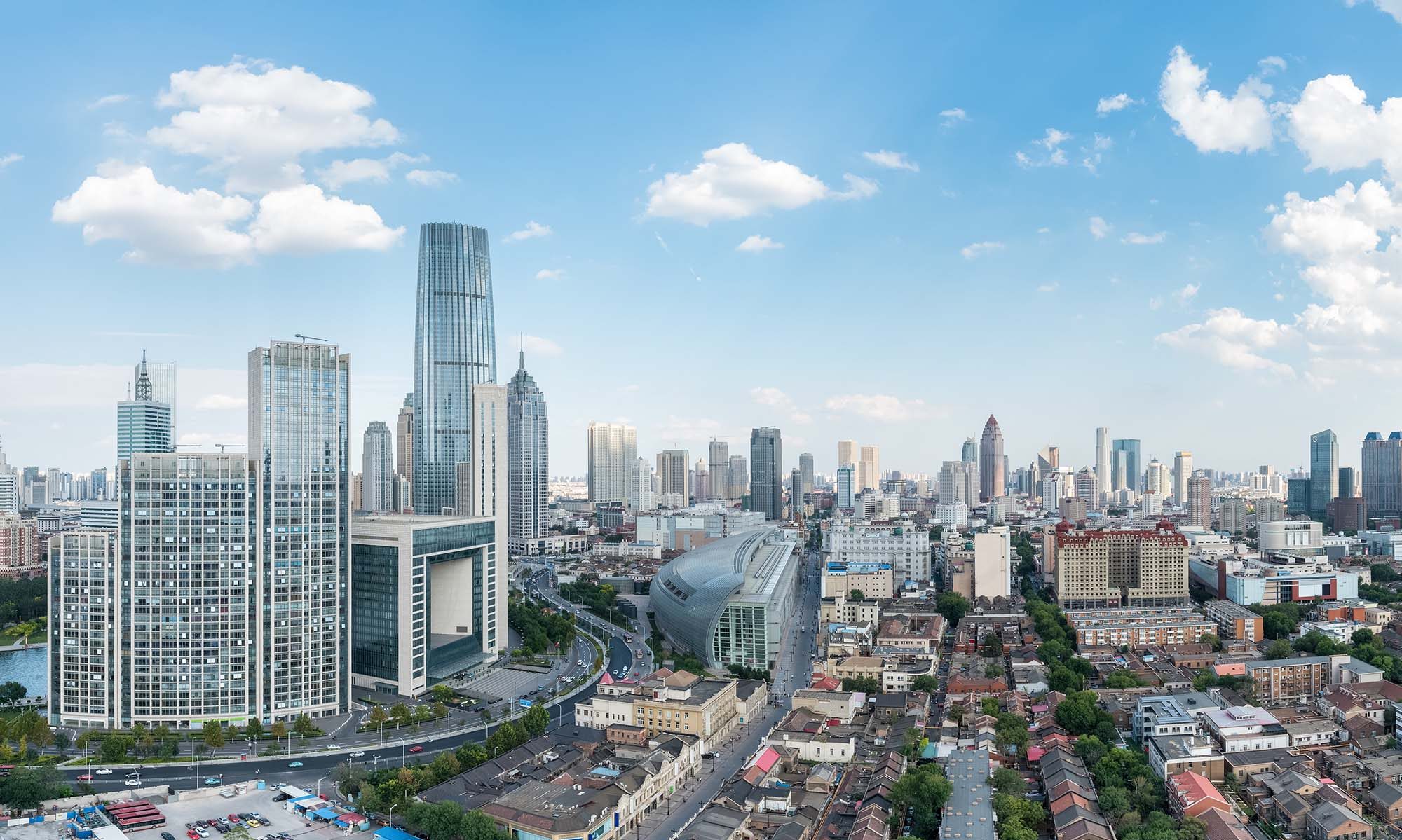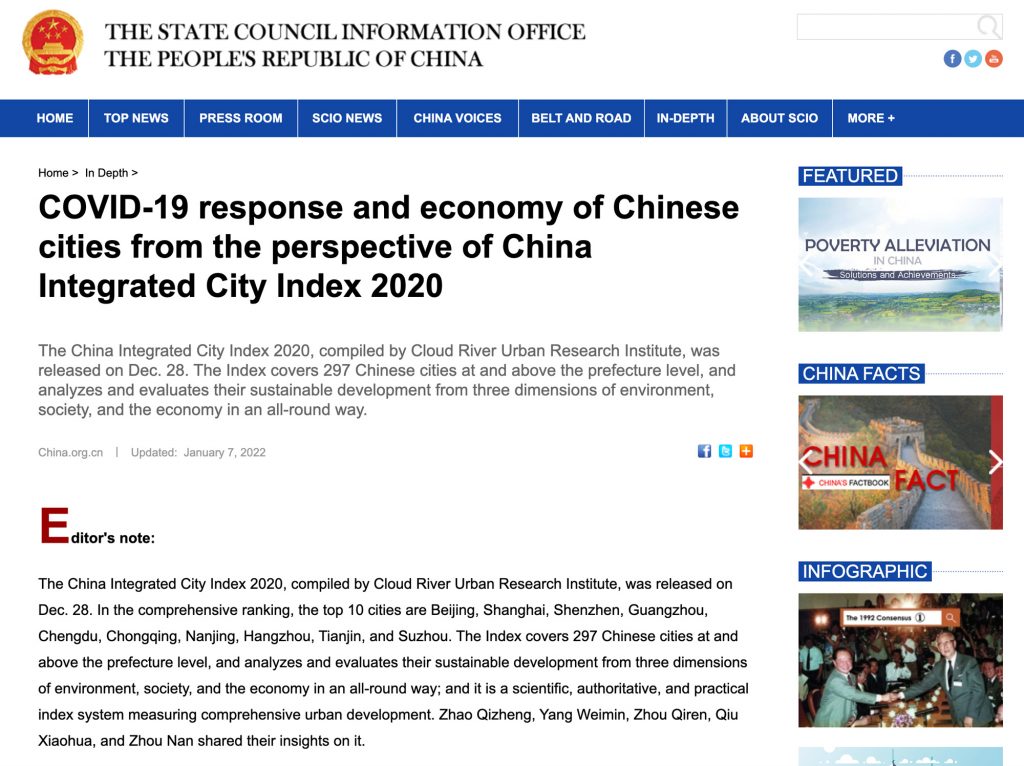
The China Integrated City Index 2020, compiled by Cloud River Urban Research Institute, was released on Dec. 28. The Index covers 297 Chinese cities at and above the prefecture level, and analyzes and evaluates their sustainable development from three dimensions of environment, society, and the economy in an all-round way.
Editor’s note:
The China Integrated City Index 2020, compiled by Cloud River Urban Research Institute, was released on Dec. 28. In the comprehensive ranking, the top 10 cities are Beijing, Shanghai, Shenzhen, Guangzhou, Chengdu, Chongqing, Nanjing, Hangzhou, Tianjin, and Suzhou. The Index covers 297 Chinese cities at and above the prefecture level, and analyzes and evaluates their sustainable development from three dimensions of environment, society, and the economy in an all-round way; and it is a scientific, authoritative, and practical index system measuring comprehensive urban development. Zhao Qizheng, Yang Weimin, Zhou Qiren, Qiu Xiaohua, and Zhou Nan shared their insights on it.
I. Rankings of China Integrated City Index 2020
The China Integrated City Index covers 297 Chinese cities at and above the prefecture level, and comprehensively evaluates their development from three dimensions of environment, society, and economy. Each of the three dimensions comprises three major items, and each major item comprises three sub-items, altogether forming a 3×3×3 structure. Each sub-item is supported by multiple indexes, and these indexes are composed of 882 sets of data, of which statistical data account for 31%, satellite remote sensing data for 35%, and internet big data for 34%. In this sense, the China Integrated City Index is an advanced multimodal index system that can use data resources in different fields to gauge and judge cities in a sound way.
The China Integrated City Index 2020 released by Cloud River Urban Research Institute evaluates the COVID-19 response and economic recovery of Chinese cities.
1. Comprehensive ranking
Beijing has topped the comprehensive ranking for five consecutive years, followed by Shanghai in second place and Shenzhen in third.
The top 10 Chinese cities in the comprehensive ranking in 2020 are Beijing, Shanghai, Shenzhen, Guangzhou, Chengdu, Chongqing, Nanjing, Hangzhou, Tianjin, and Suzhou. Chengdu and Nanjing rose to fifth and seventh place, respectively, while Suzhou entered the top 10 and Wuhan dropped out. The 10 cities are located in four city clusters, with four cities in the Yangtze River Delta, two in the Pearl River Delta, two in the Beijing-Tianjin-Hebei region, and two in the Chengdu-Chongqing economic circle.
The 11th to 30th are Wuhan, Xiamen, Xi’an, Ningbo, Changsha, Zhengzhou, Qingdao, Dongguan, Fuzhou, Kunming, Hefei, Foshan, Wuxi, Jinan, Zhuhai, Shenyang, Guiyang, Dalian, Nanchang, and Quanzhou.
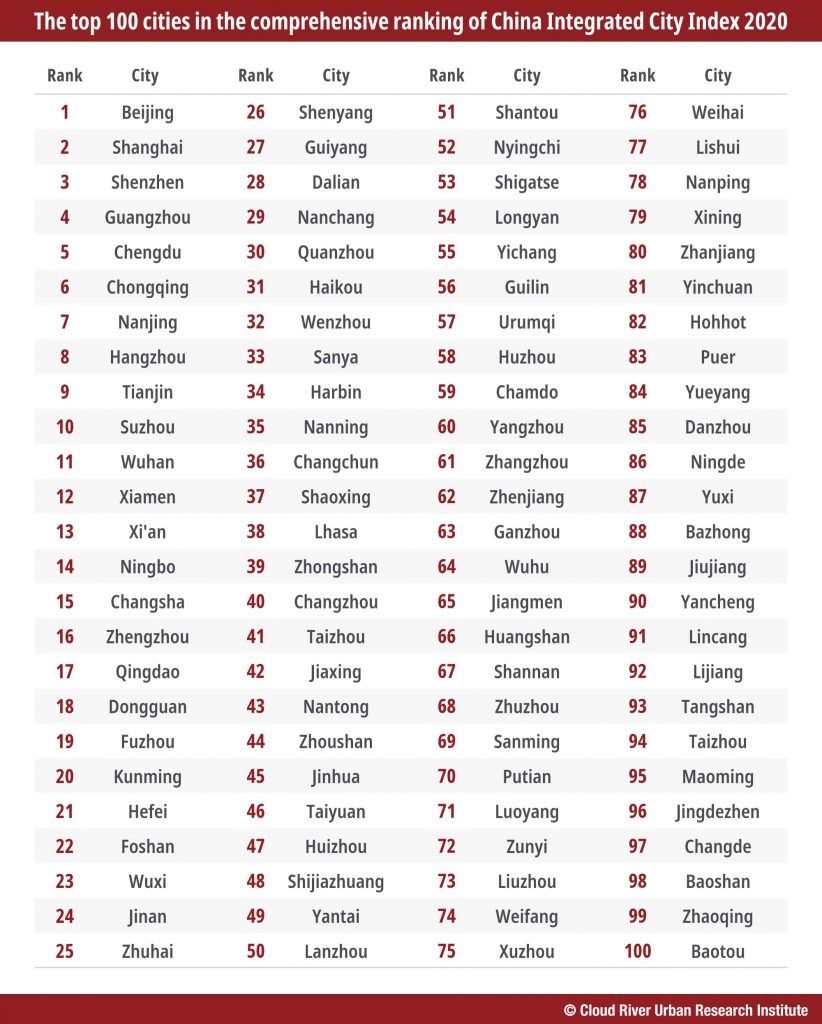
2. Ranking in environment dimension
Shenzhen has ranked first in the environment dimension for five consecutive years, followed by Guangzhou in second place and Shanghai in third.
The top 10 Chinese cities in this dimension in 2020 are Shenzhen, Guangzhou, Shanghai, Xiamen, Sanya, Nyingchi, Shigatse, Chamdo, Beijing, and Haikou. Xiamen, Sanya, and Xigaze rose to fourth, fifth, and seventh place, respectively.
The 11th to 30th are Zhuhai, Dongguan, Chengdu, Zhoushan, Shantou, Shannan, Nanjing, Chongqing, Fuzhou, Danzhou, Foshan, Naqu, Puer,Bazhong, Hangzhou, Kunming, Wuhan, Quanzhou, Zhongshan, and Changsha.

3. Ranking in society dimension
Beijing and Shanghai have ranked first and second, respectively, in the society dimension for five consecutive years, and Guangzhou has remained third for four consecutive years.
The top 10 Chinese cities in this dimension in 2020 are Beijing, Shanghai, Guangzhou, Shenzhen, Nanjing, Chengdu, Chongqing, Hangzhou, Tianjin, and Xi’an. Nanjing, Chengdu, and Tianjin rose to fifth, sixth, and ninth place, respectively, while Xi’an entered the top 10 and Wuhan dropped out.
The 11th to 30th are Suzhou, Changsha, Xiamen, Zhengzhou, Jinan, Wuhan, Ningbo, Shenyang, Qingdao, Hefei, Kunming, Fuzhou, Harbin, Wuxi, Nanchang, Guiyang, Nanning, Dalian, Taiyuan, and Changchun.
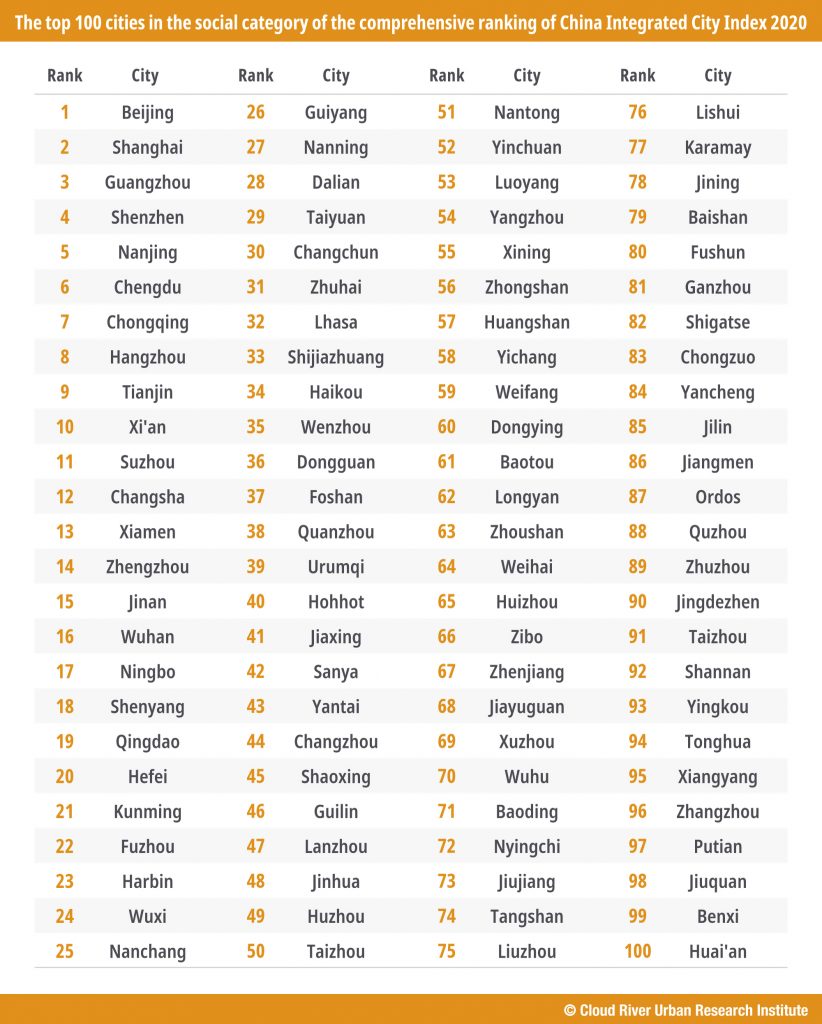
4. Ranking in economy dimension
Shanghai has topped the ranking in the economy dimension for five consecutive years, and Beijing and Shenzhen have remained second and third, respectively, for five consecutive years.
The top 10 Chinese cities in this dimension in 2020 are Shanghai, Beijing, Shenzhen, Guangzhou, Chengdu, Suzhou, Chongqing, Tianjin, Hangzhou, and Nanjing. Chengdu jumped to fifth place, while Tianjin and Hangzhou fell in the ranking.
The 11th to 30th are Wuhan, Ningbo, Dongguan, Qingdao, Xi’an, Zhengzhou, Changsha, Xiamen, Wuxi, Foshan, Jinan, Fuzhou, Hefei, Dalian, Kunming, Shenyang, Quanzhou, Wenzhou, Changchun, and Harbin.
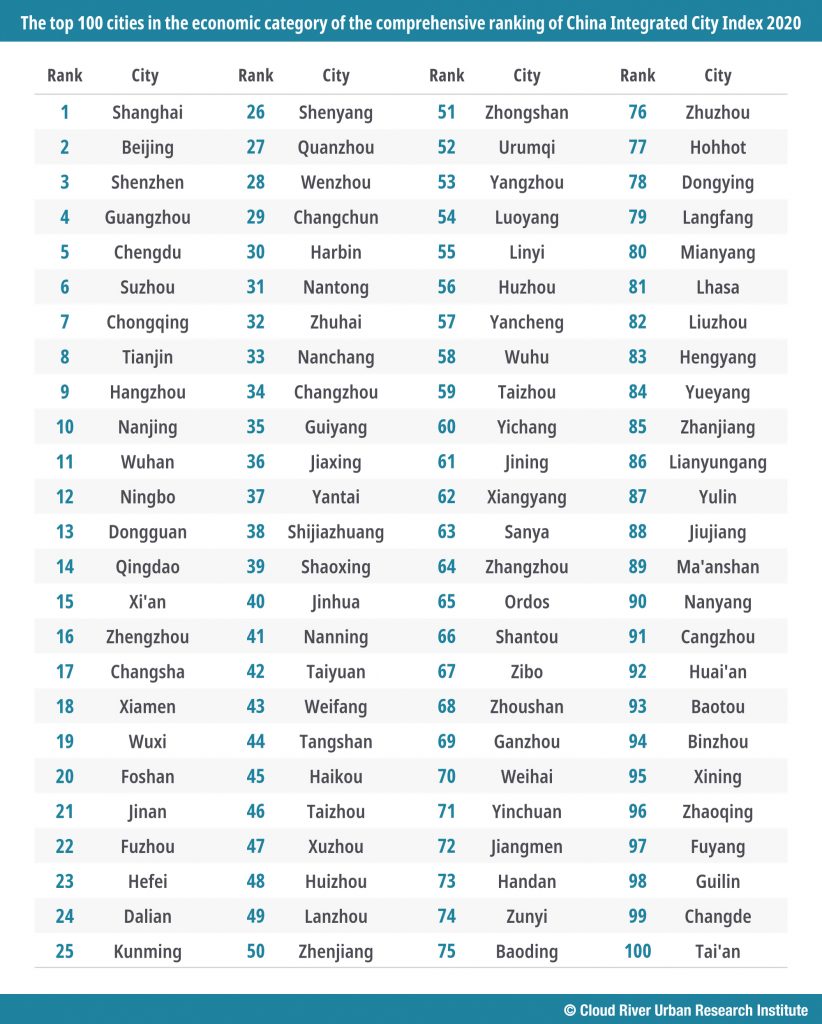
II. Strength and resilience of Chinese cities amid COVID-19 pandemic
Given that the principal theme of 2020 worldwide was COVID-19 prevention and control, the China Integrated City Index 2020 has evaluated the COVID-19 response and economic recovery of Chinese cities over the year from the dimensions of society, economy, and environment.
In terms of the COVID-19 situation, 80.8% of the newly confirmed COVID-19 cases in 2020 (excluding imported cases and asymptomatic cases) were in top 10 cities, all of which are within Hubei province. Rapidly adopted lockdown measures and the zero-COVID-19 policy quickly brought the outbreak under control, preventing other Chinese cities from explosive spread of the virus.
Thanks to the rapid control of the outbreak under the zero-COVID-19 policy, people in Chinese cities quickly resumed their life. Take entertainment in everyday life as an example. Though the movie market was one of the sectors hit hard by COVID-19, and China’s box office saw a slump of 68.2% in 2020, this decrease was relatively smaller than that of other major box offices worldwide such as the North America one, and a strong rebound made China the world’s largest movie market of the year. “The Eight Hundred,” a domestic production in China, topped the global box office for 2020, and another three Chinese movies ranked among the top 10 global box office hits of the year, namely “My Country, My Homeland” (4th), “Legend of Deification” (8th), and “A Little Red Flower” (9th). In addition, “The Sacrifice” ranked 14th. The strong rebound in the Chinese movie market pushed a number of Chinese movies to the top of the global box office.
Air transportation was also hit hard by COVID-19. Especially in the case of long-term restrictions on international travel, the passenger throughput of airports in cities declined drastically, altogether resulting in a 36.6% decrease in the passenger throughput of airports nationwide. Fortunately, air transportation in the country resumed thanks to its rapid control of the outbreak, and the decline in passenger throughput of its airports was relatively smaller compared with European countries, the U.S., and Japan.
The top 10 Chinese cities in terms of passenger throughput of airports in 2020 are Shanghai, Beijing, Guangzhou, Chengdu, Shenzhen, Chongqing, Kunming, Xi’an, Hangzhou, and Zhengzhou. Their aggregate accounted for 44.9% of the whole country, and the proportion of the top 30 cities was as high as 75.5%, demonstrating that China’s air transportation concentrated in hub cities.
Compared with the passenger throughput, the cargo throughput of airports across the country merely decreased by 6%. The top 10 Chinese cities in this term in 2020 are Shanghai, Guangzhou, Shenzhen, Beijing, Hangzhou, Zhengzhou, Chengdu, Chongqing, Nanjing, and Xi’an. Four of them — Shenzhen, Hangzhou, Zhengzhou, and Nanjing — even saw an increase in cargo throughput, showing the vitality of logistics and the rapid recovery of manufacturing supply chains amid the pandemic. The aggregate of the top 10 cities accounted for 72.8% of the whole country, and the proportion of the top 30 cities was as high as 92.5%, demonstrating an even higher concentration level of air cargo transportation in hub cities than passenger transportation.
Despite the disruption in global supply chains and global shipping amid the pandemic, which even continues to this day, most Chinese port cities saw an increase in container throughput in 2020, and the national port throughput registered a 1.2% increase, showing the strong resilience of China’s manufacturing sector in export. The top 10 Chinese cities in terms of port container throughput in 2020 are Shanghai, Ningbo, Shenzhen, Guangzhou, Qingdao, Tianjin, Xiamen, Suzhou, Yingkou, and Dalian, among which only Dalian registered a negative growth. Their aggregate occupied 70.8% of the whole country, and the proportion of the top 30 cities was as high as 92.6%, demonstrating that China’s port transportation concentrated in certain cities.
China’s export industries were hit hard by the pandemic in the first half of 2020, but saw a strong rebound in the second half. The top 10 Chinese cities in terms of the radiation ability of manufacturing in 2020 are Shenzhen, Suzhou, Dongguan, Shanghai, Ningbo, Foshan, Chengdu, Guangzhou, Wuxi, and Hangzhou. All but three of them — Suzhou, Dongguan, and Wuxi — achieved export growth. It was the strength of these cities in manufacturing that enabled China’s export volume to grow by 4% in 2020. Their aggregate export volume took up 44.2% of the national total, and the proportion of the top 30 cities was as high as 71.7%, showing that China’s export industries concentrated in these cities with large manufacturing scale and great manufacturing strength.
The year 2020 marked strides ahead of the IT industry. Digital COVID-19 response, telecommuting, online teaching, telemedicine, video conferencing, and online shopping became the norm as the pandemic dramatically pushed for the digital transformation of all sectors and people’s life. The top 10 Chinese cities in terms of the radiation ability of the IT industry in 2020 are Beijing, Shanghai, Shenzhen, Hangzhou, Guangzhou, Chengdu, Nanjing, Chongqing, Fuzhou, Wuhan, and Wuhan. Their aggregate of IT industry employment and listed companies in the industry on the main board, the SME (small and medium-sized enterprises) board, and the GEM (growth enterprise market) board accounted for 58.3%, 77.6%, 62.5%, and 75.3% of the national total, respectively, showing that the IT industry further concentrated in hub cities.
With its effective zero-COVID-19 policy, China achieved a commendable 2.3% economic growth in 2020 when other major economies in the world registered negative growth in general. Except for Wuhan, which was hit hard by COVID-19, all of the top 30 Chinese cities in terms of GDP achieved economic growth in 2020, fully demonstrating the resilience of Chinese cities in the face of difficulties brought by COVID-19. The top 10 Chinese cities in terms of GDP in 2020 are Shanghai, Beijing, Shenzhen, Guangzhou, Chongqing, Suzhou, Chengdu, Hangzhou, Wuhan, and Nanjing. Their aggregate GDP accounted for 23.3% of the national total, and the proportion of the top 30 cities was up to 43%, showing that China’s economic growth concentrated in cities ranking high in this term.
III. Expert comments
Zhao Qizheng, Yang Weimin, Qiu Xiaohua, Zhou Qiren, Zhou Nan, and Zhou Muzhi shared their insightful comments on the performance of Chinese cities in 2020 on the release of the China Integrated City Index 2020.

Zhao Qizheng
Dean of the School of Journalism and Communication of Renmin University of China and former minister of the State Council Information Office
The China Integrated City Index 2020 has been released. In my opinion, the most distinct feature of the Index is that it focuses on the COVID-19 pandemic and analyzes its impact on Chinese cities based on multiple indexes.
Outbreaks causing unprecedented damage to human beings, such as the novel coronavirus one, are not frequently seen. The Index has carefully analyzed the impact of this major disaster on urban development, and these research results are of great value for dealing with similar situations in the future.
The novel coronavirus had borne down menacingly, and although countries around the world moved quickly to develop vaccines and effective cure, these efforts take time. China implemented comprehensive lockdown measures and the zero-COVID-19 policy in a timely manner, managing to make up for the time lag.
Countries around the world hold different views on its approach. Fortunately, due to Chinese cultural traditions, its people did not resist much to lockdown, quarantine, and face masks. Professor Zhou Muzhi and Cloud River Urban Research Institute have conducted studies on the effectiveness of China’s anti-COVID-19 policies since the outbreak, which have played a good role in the international understanding and reference of China’s anti-COVID-19 measures.
In the fight against the novel coronavirus, Chinese cities have given full play to the role of internet technology and made extensive use of artificial intelligence, cloud computing, big data, blockchain, and other technologies to effectively prevent cross infection in the flow of people. The national health code and travel code have been accepted by the public and put into practice in China; however, these practices are not accepted in many other countries due to cultural and governance differences.
In 2020, COVID-19 had a profound impact on the social and economic development of cities in China and around the world. The analysis of the China Integrated City Index 2020 on 297 Chinese cities at and above the prefecture level is of great significance for understanding and evaluating anti-COVID-19 policies and COVID-19 impact on urban development. This is also a feature not presented by previous Indexes, so I hope it can draw the attention of municipal leaders and sociologists. Of course, this Index has its important value for foreign scholars and research institutes studying the pandemic to refer to.

Yang Weimin
A member of the Standing Committee of the Chinese People’s Political Consultative Conference National Committee, and former deputy director of the Office of the Central Leading Group for Financial and Economic Affairs of China
The COVID-19 outbreak disrupted everything, but Cloud River Urban Research Institute released its China Integrated City Index 2020 as scheduled. I said the Index is a health checkup of Chinese cities. A health checkup should be taken on a yearly basis no matter what happens. A health examination is more important during an outbreak.
The China Integrated City Index 2020 looks at the development of Chinese cities amid the outbreak and identifies their resilience and performances.
China has stood out among global major economies since the COVID-19 outbreak. Its economy grew by 2.3% in 2020, and grew by 9.8% in the first three quarters of 2021 and is expected to grow around 8% for the whole year, with per capita GDP reaching $12,000, up by 2,000 from 2020. Its strong showing was the result of the effective measures rolled out by the Chinese government, and also the result of the resilience of the Chinese economy. Its resilience lies in its complete industries, manufacturing capability, supporting industries, exporting capability of manufactured goods, and the cluster of industries. Such a distinctive resilience put the Chinese economy on a stable footing through foreign trade, even when China’s domestic investment and consumption were hit by the epidemic. The U.S. government can impose sanctions against Chinese companies, but cannot curb the strong demand of U.S. consumers for Chinese goods. In 2020, Chinese net export in goods and services contributed 28% to China’s economic growth, and contributed as high as 19.5% in the first three quarters of 2021, beating the highest level of 14.3% in 2006 before the international financial crisis.
The Index shows that the top 10 and the top 30 Chinese cities in terms of manufacturing radiation accounted for 44.2% and 71.7% of China’s export volume, respectively, demonstrating their sound development and resilience.
Entering the new stage, China’s economy will foster a new development paradigm featuring “dual circulations,” with domestic and international circulations reinforcing each other. Some Chinese countries are expected to continue to play a leading role in the new development paradigm.

Zhou Qiren
Professor at the National School of Development of Peking University
The Index will become more relevant over time. The new edition allows audiences to examine the correlation between economic and social variants, which is essentially the complex connection between people and organization behavior in cities.
Here, “comparison” always occupies a basic and central position in empirical research. Any information that renders itself to comparison, therefore, is generally conducive to understanding and applying the law of urban comprehensive development. When it comes to comparison, Deng Xiaoping said during his visit to Singapore in 1978, “If you want to compare, compare with the world.” His statement is worth revisiting. It is very important for domestic cities to compete with each other, and it is also important to learn from international modern cities. I suggest that Professor Zhou consider adding a group of international city data to the future “China Integrated City Index” to enrich comparison.

Qiu Xiaohua
Vice chair of Cloud River Urban Research Institute and former head of the National Bureau of Statistics
My takeaways from the China Integrated City Index 2020 are as follows.
(1) A city’s economic strength is still the determinant of its status. A city’s future, its comprehensive strength and the realization of its goals rest on its economy.
(2) Green elements are more and more important. The city’s green transformation stimulates its development potential. The change in the ranking of comprehensive strength is the result of the emphasis on green development.
(3) The development of social and public utilities becomes more and more important. The outbreak has dented economic and social development and affected people’s livelihood, but it has also tested the emergency management facilities and capacities of cities. Those cities at the top of rankings tend to have comparative strengths in this regard.
(4) China’s development has entered a new stage, setting the construction of a new pattern paradigm in motion. Chinese cities tend to form city clusters, ushering in an era that pays more attention to the leading role of central cities. We expect Chinese cities to foster a healthier development pattern.

Zhou Nan
Deputy director-general of the Department of Development Planning of the National Development and Reform Commission
The sudden outbreak of COVID-19 raged the world in 2020, disrupting people’s lives and businesses. China has struck a balance between prevention and control measure, economic development, and social stability.
The Index revealed that the top 30 Chinese cities by measure of GDP in 2020, except Wuhan, all registered a positive growth between 1% and 5%, making China stand out in the world’s economies.
In terms of regional development, the Yangtze River Delta and the Pearl River Delta retained their advantages in economic, environmental and social fronts. Among the top 100 Chinese cities in comprehensive ranking, 21 cities are from the Yangtze River Delta, and 12 from the Pearl River Delta. Among the top 10 cities, four are from the Yangtze River Delta. With labor division and cooperation strengthening within the region, city clusters and metropolitan areas serve as a pacesetter, and emerging advantages in regional competition become a key carrier in international competition and cooperation.
Some cities performed differently, though the overall ranking is largely static. In 2020, quite a few cities along the middle reaches of the Yangtze River fared well, except some cities in Hubei. For instance, Hefei climbed from 26th to 21st, Zhuzhou from 71st to 68th, Jiujiang from 98th to 89th. In contrast, northern Chinese cities slipped in their rankings. From 2018 to 2020, Shenyang dropped from 19th to 26th, Harbin from 29th to 34th, Changchun from 30th to 36th, Yinchuan from 67th to 81st, and Hohhot from 56th to 82nd. Their ranking rejig resulted from their changes in economic, environmental and social indexes, echoing the Chinese old saying, “A boat sailing against the currents has to forge ahead or risks falling behind.”
Cities also differed in their rankings of industrial radiation. On one hand, industries that do not fit the mega cities began to relocate in 2020, with Shanghai and Guangzhou falling by two spots compared with 2018. On the other hand, cities boasting good scientific and technological and industrial foundations and a large talent pool caught up, with Chengdu, Xi’an, Nanjing, and Wuxi climbing by four to seven spots, and Wuhan and Xiamen making their way into the top 10. This reveals that labor division in cities have become reasonable and central cities have played a bigger role.
Any index system cannot be perfect and impeccable in any case. The Index, however, can easily and clearly measure the comparable strength of cities and their progress. A close examination of the Index gives me insights from different perspectives.

Zhou Muzhi
Head of Cloud River Urban Research Institute and professor at Tokyo Keizai University
Since the outbreak of COVID-19, Cloud River Urban Research Institute has paid close attention to the effectiveness of prevention measures and the performance of Chinese cities in the outbreak. On April 17, 2020, the institute released the report “COVID-19: Why is medical system in metropolises so vulnerable?” analyzed why international metropolises were crippled by the collapse of medical systems amid COVID-19 pandemic and assessed the measures adopted by Wuhan in the outbreak and recommended its measures to other countries. The article “Global COVID-19 responses: ‘Zero COVID-19 Case Policy’ vs. ‘Coexisting with COVID-19 Policy’,” published on Nov. 11, 2020, compared Chinese prevention and control measures to their Western and Japanese counterparts, and assessed the effectiveness of “Zero COVID-19 Case Policy.” Those reports and articles, all available in English and Japanese versions, helped the international community to understand the effectiveness of Chinese prevention and control measures.
At the same time, the institute gathered experts to research and discuss the impact of the pandemic on globalization, international metropolises, global supply chains, and IT, entertainment, aviation, and maritime industries in the form of theses, reports, dialogues, and seminars.
Based on the previous four editions of “China Integrated City Index” and the above research, the China Integrated City Index 2020 focuses on Chinese cities’ success in beating back the virus as well as the impact of the epidemic on related industries, and delivers the “health checkup” of Chinese cities amid the epidemic.
The China Integrated City Index 2020 shows that China’s economic prowess lies in its strong resilience of leading cities and effective anti-epidemic measures provide a solid foundation for China’s urban development.
The article was first published on China.org.cn on Jan. 5, 2022 and reprinted by other news websites.
